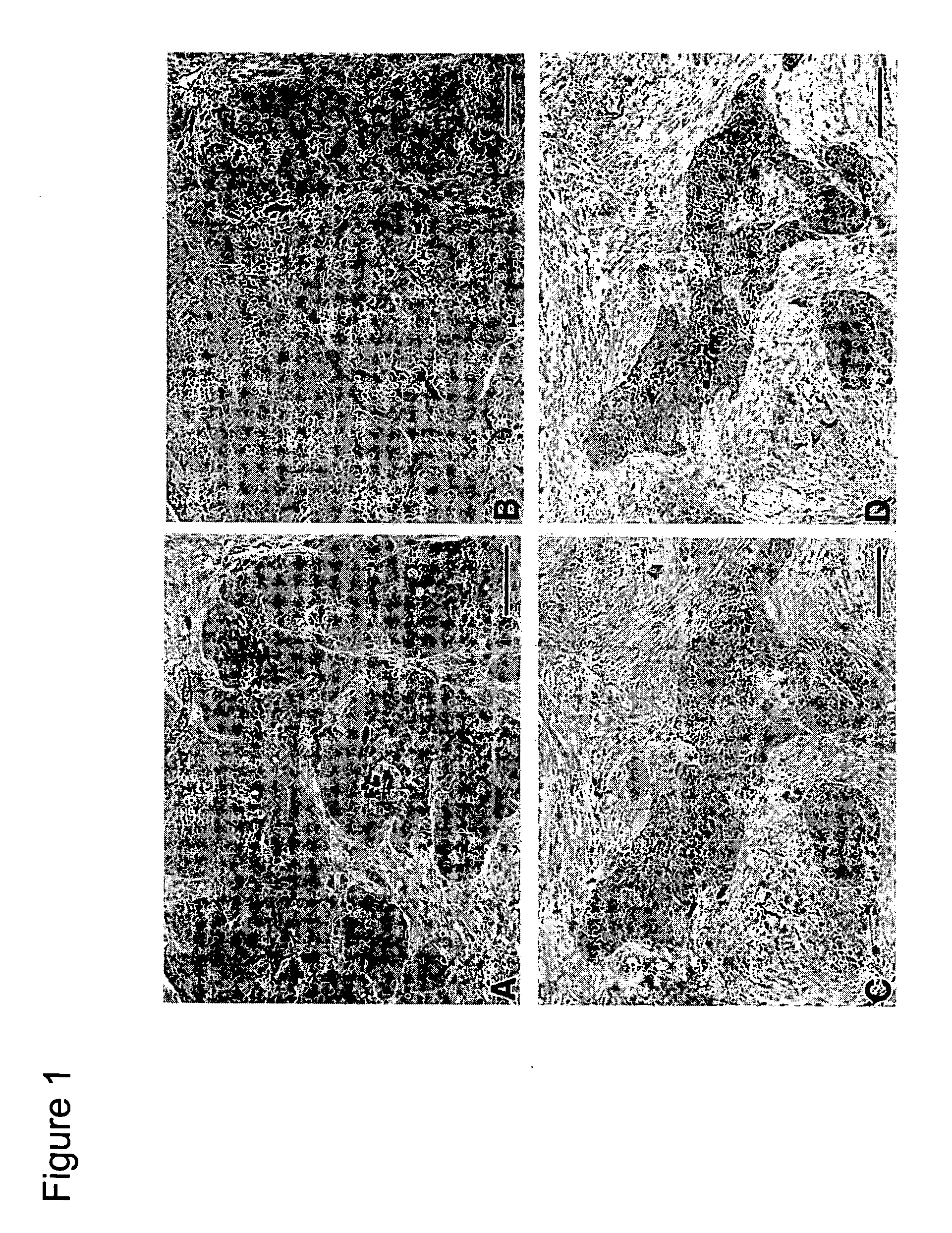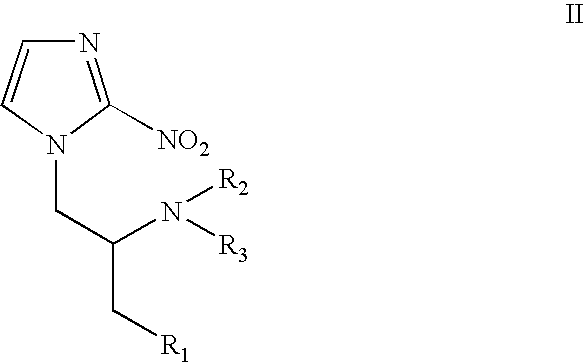Weakly basic 2-nitroimidazoles for the non-invasive detection of tissue hypoxia
a technology 2nitroimidazoles, which is applied in the field of weakly basic derivatives of 2nitroimidazoles, can solve the problems of uncontrollable fluctuations in hypoxia, unsuitable routine, and less desirable, and achieve the effect of increasing the detection sensitivity of mrs/mri
- Summary
- Abstract
- Description
- Claims
- Application Information
AI Technical Summary
Benefits of technology
Problems solved by technology
Method used
Image
Examples
example 1
[0068]
[0069]The starting material (1) (460 mg, 1.8 mmol) was dissolved in 50 ml THF and Et3N (0.5 ml) was added and followed by dropwise addition of MsCl (0.28 ml, 3.6 mmol). The reaction was stirred at room temperature for 20 min. Thin layer chromatography (TLC) showed the starting material was almost completely reacted. After the workup the crude reaction product was purified by column chromatograph (EtOAc) to afford 500 mg of desired mesylated product (2) (yield is 84%). 1HNMR(DMSO-d6, δppm): 1.63 (m, 2H, CH2), 1.90 (m, 4H, 2xCH2), 2.10 (m, 2H, CH2), 2.24 (t, 2H, CH2, J=6.9 Hz), 2.48 (m, 2H, CH2), 3.15 (s, 3H, CH3), 4.41 (t, 2H, CH2, J=6.9 Hz), 4.60 (m, 1H, CH), 7.15 (d, 1H, CH═, J=1.2 Hz), 7.65 (d, 1H, CH═, J=1.2 Hz).
[0070]Kryptofix 222 (270 mg, 0.72 mmol) was dissolved in 5 ml of acetonitrile (CH3CN). To this solution was added anhydrous powder potassium fluoride (99.99+%, 33 mg, 0.57 mmol) followed by mesylate (2) (80 mg, 0.24 mmol). The resulting mixture was refluxed for 2 hr...
example 2
[0071]
[0072]The starting material (4) (4 g, 14.85 mmol) was dissolved in 200 ml THF. To this solution was added Et3N (5 ml) followed by dropwise addition of MsCl (3 ml, 38.8 mmol). The reaction was stirred at room temperature for 30 min. TLC showed that the starting material was almost all consumed. After the workup, the crude reaction mixture was purified by flash column chromatograph (EtOAc) to afford 3.1 g of di-mesylated product (5), yield is 49.1%. 1HNMR(DMSO-d6, δppm): 1.71 (m, 2H, CH2), 1.93 (m, 2H, CH2), 2.47 (m, 2H, CH2), 2.68 (m, 4H, 2x CH2), 3.05 (s, 3H, CH3SO—), 3.16 (s, 3H, CH3SO—), 4.55 (dd, 1H, imidazole-CHa—, J=14.4 Hz, 8.7 Hz), 4.66 (m, 1H, O—CH), 4.84 (dd, 1H, imidazole-CHa—, J=14.4 Hz, 8.7 Hz), 5.00 (m, 1H, O—CH), 7.16 (d, 1H, imidazole, J=0.9 Hz), 7.59 (d, 1H, imidazole, J=0.9 Hz).
[0073]Kryptofix 222 (MW 376.5, 42 mg, 0.112 mmol) was dissolved in 2 ml of acetonitrile (CH3CN). To this solution was added anhydrous potassium fluoride (99.99+%, 22 mg, 0.379 mmol) fol...
example 3
[0074]
[0075]Pimonidazole (3.7 g, 14.5 mmol), p-toluenesulfonic anhydride (5.7 g, 17.5 mmol) and DMAP (1.78 g, 14.5 mmol) were added to 100 ml of anhydrous CH2Cl2 at 0° C. in an ice-water bath. After stirring for 30 min, the reaction was quenched with water and extracted with ethyl acetate. The organic phase was washed with water, dried over anhydrous sodium sulfate, filtered and concentrated. The crude reaction product was purified by column chromatography (EtOAc-Hexane=1:1) to afford 4.1 g (70% yield) of the desired tosylate (7, III). For compound (7, III): 1H NMR (CDCl3, δppm): 1.41(m, 2H, CH2), 1.52 (m, 4H, 2xCH2), 2.33-2.67 (m, 6H, 3xCH2), 2.44 (s, 3H, CH3), 4.29 (dd, 1H, imidazole-CHa—, J=14.4 Hz, 8.7 Hz), 4.87 (m, 1H, O—CH—), 4.97 (dd, 1H, imidazole-CHb—, J=14.7 Hz, J=2.7 Hz), 7.03 (d, 2H, Benzene, J=8.4 Hz), 7.25 (d, 1H, imidazole, J=0.6 Hz), 7.26 (d, 1H, imidazole, J=0.6 Hz), 7.54 (d, 2H, Benzene, J=8.4 Hz). 13C NMR(CDCl3, δppm): 21.87, 24.17, 26.10, 52.08, 55.58, 60.04, 77....
PUM
| Property | Measurement | Unit |
|---|---|---|
| pKa | aaaaa | aaaaa |
| pKa | aaaaa | aaaaa |
| pH | aaaaa | aaaaa |
Abstract
Description
Claims
Application Information
 Login to View More
Login to View More - R&D
- Intellectual Property
- Life Sciences
- Materials
- Tech Scout
- Unparalleled Data Quality
- Higher Quality Content
- 60% Fewer Hallucinations
Browse by: Latest US Patents, China's latest patents, Technical Efficacy Thesaurus, Application Domain, Technology Topic, Popular Technical Reports.
© 2025 PatSnap. All rights reserved.Legal|Privacy policy|Modern Slavery Act Transparency Statement|Sitemap|About US| Contact US: help@patsnap.com



